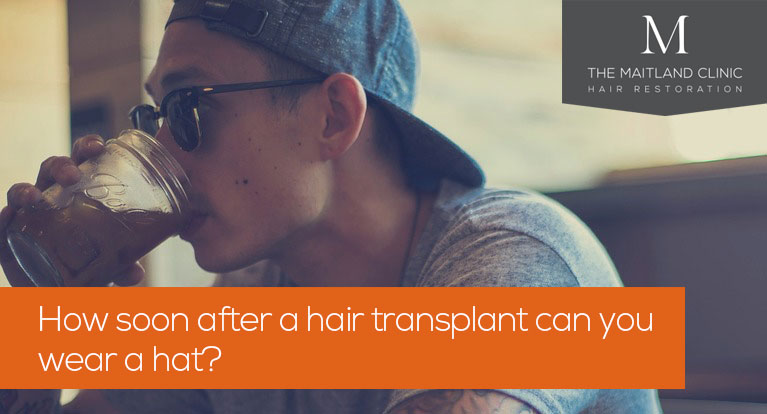Can you wear a hat after a hair transplant and how long after the procedure?
21st October 2019

At The Maitland Clinic we understand that patients may feel conscious about their appearance after a hair transplant. With many people keen to conceal their scalp immediately following their surgery, a question we are often asked is about how soon after a hair transplant you can wear a cap or hat.
How soon after a hair transplant can you wear a hat or cap? To avoid damaging the fragile new hair grafts we recommend that you wait until six days after your hair transplant before wearing a hat. If you need to cover your scalp before the sixth day, it may be possible to wear a very loose-fitting hat or light hood, providing it does not come into contact with the grafts.
The two main types of hair transplant surgery carried out at The Maitland Clinic are known as Follicular Unit Transplant (FUT or Strip) and Follicular Unit Excision/Extraction (FUE). Both of these procedures involve taking healthy hair follicles from a donor area and then transplanting them into the recipient areas of the scalp affected by hair loss. Small incisions are made in the patient’s scalp and the hair grafts are then implanted into these with great care and precision.
The implanted grafts are very fragile and should not be touched for the first five days after surgery. Following your procedure, your scalp may be red and swollen, and you will experience some scabbing during the first few days. It is natural to feel conscious about your appearance during this early phase and you may prefer to cover your head to hide any signs of surgery. However, you should always follow the advice of your care team to help you achieve the best possible results from your procedure.
We will give you comprehensive instructions on how best to care for your grafts following surgery, including advice on when you can wash your hair, wear a hat and resume other regular activities.
How soon after a hair transplant can I wear a hat?
We normally advise patients to avoid wearing any sort of head covering during the first five days after a hair transplant. This is because items such as hats increase the risk of compressing and dislodging the newly implanted hair grafts. Any damage to the grafts at this crucial stage could create empty spots on the scalp, jeopardising the success of the whole procedure. Wearing a tight hat may also irritate the scalp, which may be sensitive during the healing period. The hair grafts are usually secure from day six onwards, at which point it is fine to wear a hat.
How can I conceal my scalp after a hair transplant?
Although we recommend waiting until day six before wearing a hat, it is possible to cover your scalp before this, providing you take extra care not to damage the grafts. Should you wish, we can wrap your scalp in clingfilm and place a light hood over the top. You can repeat this procedure if you wish to continue concealing your scalp during the first five days of recovery.
If you do wish to cover your scalp as you leave the clinic after surgery, we recommend the cling film and hood method rather than a cap or hat. This is because we apply a large white headband dressing which is not really compatible with a hat.
If you do choose to wear a hat during the first five days, you should choose it wisely. Opt for an adjustable, loose-fitting hat that is as wide as possible around your head – it should not come into contact with the hair grafts.
Hats with a firm structure can work well because they sit proud of the treated area. Firm baseball caps with a plastic mesh back tend to be best. However, a light hood worn over a clingfilm wrapping does a better job of concealing the donor area.
When taking the hat or hood off, be careful not to make contact with the transplanted area of the scalp. The same applies for other items of clothing. It is safest to wear tops with buttons or zips at the front to avoid the need to remove clothing over your head.
Ideally, the scalp is left exposed during the first two or three days to allow you to maintain the half hourly ATP aftercare spray routine.
Please contact The Maitland Clinic if you would like further advice on caring for your grafts following a hair transplant.
Other related questions about hair transplant recovery
How long does a hair transplant take to heal?
Your scalp should be healed and free of scabs 10 days after a hair transplant. FUT surgery will leave a linear scar in the donor area, while FUE leaves a series of tiny dot scars. In most cases, you will begin to see new hair growth in the treated areas of the scalp after around four months. The new hairs will start to thicken over the next few months, with the majority of hair growth occurring between five and 12 months after surgery.
When can I return to work after a hair transplant?
At The Maitland Clinic we usually advise that you can return to work on the tenth day after your surgery. By this point, your scalp should be healed and the scabs will normally be gone. It may be possible to return to work before this, however, please be aware that your scalp may show some signs of redness and crusts in the transplanted and donor areas.
How soon after a hair transplant can I exercise?
We advise patients to avoid strenuous exercise for the first 10 days following hair transplant surgery. This is because physical activity raises your heart rate and blood pressure, which increases the risk of bleeding and swelling in the donor or recipient areas of the scalp.
In some cases, it may be possible to undertake a light form of exercise, such as walking or yoga, as early as four days after your treatment. However, you should always speak to your surgeon for advice tailored to your circumstances. See our blog post ‘How soon after a hair transplant can I exercise?’ for more information.
Can I smoke after a hair transplant?
We recommend that patients stop smoking as soon as possible before undergoing hair transplant surgery and avoid smoking for as long as possible afterwards. As a minimum you should stop at least 10 days prior to surgery, and for two weeks afterwards.
Smoking threatens the success of a hair transplant as the chemicals in cigarettes restrict blood flow to the scalp. To achieve the best possible results, there should be plenty of blood and oxygen reaching the implanted grafts. Read more in our blog post: How soon after a hair transplant can I smoke cigarettes?
Artistry and aftercare at The Maitland Clinic
The Maitland Clinic has an excellent record of performing successful FUT and FUE hair transplants. Our leading surgeon, Dr Edward Ball, is a world-renowned expert in hair restoration. His technical skill, experience and artistry means he is able to create a perfectly natural look that blends seamlessly with the rest of your hair. You can view our results in our online gallery.
As a patient of The Maitland Clinic you will also benefit from an exceptional aftercare service. You are welcome to return to us at any point following your procedure, whether that’s weeks, months or even years later, giving you access to a lifetime of professional haircare.
To book a consultation please call us on 02392 706 122 or email us at enquiries@themaitlandclinic.com.










